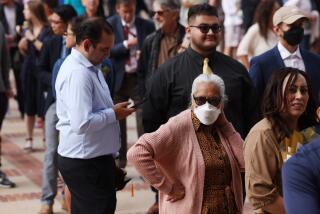Reported Flu Cases Drop 90% in County
- Share via
This year, Isela Sanchez thought she had beaten the flu bug. By February, the fever, body aches and chills that historically had haunted her during the early winter months hadn’t arrived.
Then came Super Bowl Sunday. Her family noticed that she wasn’t cheering or screaming as she usually does during football games. Her throat was sore, and she knew exactly what that meant. Her doctor diagnosed her with influenza.
“I think it just started later this year. I got my family sick and I got the people upstairs sick,” she said, referring to her co-workers at Eisner Pediatric and Family Medical Center south of downtown Los Angeles.
She is in the unlucky minority this year.Despite delays in the delivery of the influenza vaccines in 2000 and 2001, Southern California has had a steady drop in the number of influenza cases compared to past years.
Experts attribute the change to factors ranging from better access to the flu shots to a decrease in travel and an improvement in the way vaccines are created.
There were 170 influenza cases reported in Los Angeles County during the winter months of 2000-2001, said Dr. David Dassey, deputy chief of the acute communicable disease control unit at the county health department. Only 18 have been reported since the 2001-2002 flu season began in November, a little more than 10% of the previous season’s number.
“In a good flu season, we would have three to four hundred [reported] cases,” he said.
The rate has been low nationwide too, although 13 states reported widespread influenza outbreaks this month, according to U.S. Centers for Disease Control and Prevention statistics.
The statistics are only an indicator, not a precise measure, of what is actually happening. It is too costly for each state to test each patient who comes to the hospital with flu-like symptoms, and some who become ill do not to seek medical attention at all. Statistics are based on the reports from selected laboratories, mortality cases and doctors who volunteer to send cultures from patients who come in with respiratory problems and a fever of at least 100 degrees, said Carl Stevens, an emergency medicine physician at Harbor-UCLA Medical Center.
Stevens directs the hospital’s fast-track flu program, which was designed to expedite the treatment of influenza patients. It emerged from the 1999-2000 epidemic when emergency rooms across the state struggled to treat an overload of patients with respiratory problems.
“We have used the same surveillance systems for the past five years, and all of the indicators have been lower than we would expect to see in the average season,” said Robert Murray, epidemiologist with the California Department of Health Services.
Influenza changes constantly, which makes the virus very difficult to predict, experts said. When it replicates it is likely to mutate, producing different strains. Whether new strains emerge can make the difference between a low season and a severe epidemic.
“It depends on whether there is a novel virus present--and if it is novel, if it has the qualities that would allow it to spread quickly and cause serious illnesses or death,” Dassey said.
Dassey said most of the strains circulating now are the same as the one present during recent seasons. Many people’s immune systems might already have defenses against those particular forms of the virus.
Those same strains were included in the vaccines delivered during the fall, optimizing the level of immunization. The fact that fewer people are traveling this year might have helped prevent the spread of flu.
“People are not mingling in the way they used to,” Dassey said. “Fewer people are getting on airplanes and transmitting their germs to other people,” he said, alluding to changes in travel linked to the Sept. 11 attacks.
Irma Gonzalez, a pediatrician with Eisner Pediatric and Family Medical Center, said the vaccine protects people from the flu virus but cannot keep people from getting colds or other respiratory diseases.
“The vaccine is against influenza, not colds,” she said.
“Even though we give them the vaccines, they still are going to get colds. Unless you put them in a bubble,” she said, adding that the center immunizes only children with chronic respiratory problems. In truth, health officials said, the flu remains highly unpredictable.
“If the season is going to blow up in a week, there is no way to know,” Dassey said. “Predicting influenza can be hazardous to an epidemiologist’s health,” Murray said.





